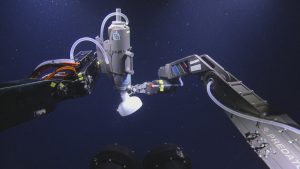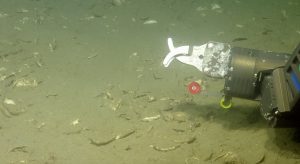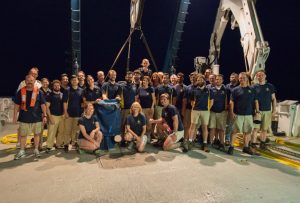Study Tracks Ocean Methane Dissolution with Environmental Data and Computer Models
– JULY 23, 2019
Scientists traced and analyzed methane bubbles as they ascended from a deep seafloor seep to the ocean’s surface and compared results to two computer models’ output to better understand methane dissolution processes. The study confirmed that changes in methane stable carbon isotopic ratios can be used as a tracer for methane dissolution through the water column. Analyses showed that over half of the methane concentrations dissolved immediately following seafloor release and 90+% dissolved by the time the bubbles ascended 400 meters. Bubble size affected methane dissolution, with smaller bubbles having a faster dissolution rate than larger bubbles. However, increasing the starting bubble diameter in model simulations did not account for the heaviest methane concentrations measured in the water column, suggesting that microbial oxidation of dissolved methane may also have played a limited role in methane dissolution.
The researchers published their findings in Geochemistry, Geophysics, Geosystems: Using carbon isotope fractionation to constrain the extent of methane dissolution into the water column surrounding a natural hydrocarbon gas seep in the northern Gulf of Mexico.
Methane is an important greenhouse gas whose emission patterns are essential to assessing climate change. One of the largest hydrocarbon reservoirs is found buried within ocean sediments, and these reservoirs inject bubbles, primarily composed of methane, into the water column. This natural release of methane will likely increase with higher ocean temperatures.
“In the Gulf of Mexico, large quantities of methane rise through the water column in the form of gas bubbles,” explained study author Mihai Leonte. “These bubbles represent a relatively rapid transport mechanism of this fossil fuel and potent greenhouse gas from sub-seafloor reservoirs to the atmosphere. Understanding how quickly these bubbles rise and dissolve will help us determine how much of this potent greenhouse gas reaches the atmosphere directly.”
However, the rate of bubble dissolution through the water column can affect how far up methane is transported and whether it reaches the atmosphere; therefore, more than bubble detection is needed to determine the fate of ocean methane This study’s research team analyzed the differences in dissolution efficiency of methane’s two natural carbon isotope species at the seafloor and in the water column to determine how much methane dissolved.
Using the remotely operated vehicles Hercules and Argus the team collected water and gas samples atop an 888-meter-deep seafloor seep (one of the Gulf of Mexico Woosley Mound seeps). The ROV’s precise positioning capabilities allowed operators to track the bubble stream’s changing position in the water column and collect water and gas bubble samples from 888 – 122 meters depth. The team compared the environmental data with outputs from two model approaches.
The Instantaneous Product Rayleigh Model calculated the fraction of methane dissolved in the water column. The results were compared with simulations generated by a modified version of the Texas A&M Oil Spill (Outfall) Calculator (TAMOC) single bubble module. The TAMOC measured the fraction of methane dissolved and the changing methane isotopes in the ascending bubbles’ gas and dissolved phases and helped explain the spread in measured isotopic ratios. The Instantaneous Product Rayleigh Model and the TAMOC model were in good agreement, and the TAMOC model showed good agreement with measured water column data.
Leonte explained further about the novel approach they used, “We investigated different methane isotopes to determine how quickly methane is dissolving at different depths. By following the vertical structure of a gas bubble flare, we were able to show how changes in the ratio of methane isotopes trace the process of methane dissolving out of gas bubbles into the surrounding water.”
In addition to showing that methane dissolves very aggressively when gas bubbles are first released from the seafloor and as they ascend, Leonte said, “Our study also suggests that methane released as bubbles at a seafloor of roughly 900 meters depth is contained within ocean waters rather than reaching the atmosphere directly.”
This study helps advance oil spill science because methane is released during a deep-sea oil spill as Leonte explained, “During Deepwater Horizon, methane comprised a significant fraction of the total hydrocarbons released. The dissolution of gas bubbles determines over what range of depths methane dissolves, making it bioavailable towards methane oxidizing bacteria that can ultimately remove methane from the water column and prevent it from reaching the atmosphere.”
Leonte said that studies investigating methane oxidation following the oil spill showed that microbes oxidized nearly all the methane released over the next few months (Science, Kessler et al., 2011 and Environmental Science & Technology, Due & Kessler, 2012). “Our study shows the proportion of methane dissolution that occurs at and above the seafloor where hydrocarbon gas bubbles are released. In future oil spill events, the analysis of methane isotopes can help determine where in the water column methane becomes available towards microbial oxidation and whether it reaches the atmosphere directly.”
Data are publicly available through the Gulf of Mexico Research Initiative Information and Data Cooperative (GRIIDC) at doi:10.7266/N7610XXW, doi:10.7266/N79K48TN, and doi:10.7266/n7-g26b-a359.
The study’s authors are Mihai Leonte, Binbin Wang, Scott A. Socolofsky, Susan Mau, John A. Breier, and John D. Kessler.
By Nilde Maggie Dannreuther and Stephanie Ellis. Contact maggied@ngi.msstate.edu with questions or comments.
************
This research was made possible in part by a grant from the Gulf of Mexico Research Initiative (GoMRI) to the Center for the Integrated Modeling and Analysis of Gulf Ecosystems II (C-IMAGE II) and the Gulf of Mexico Integrated Spill Response (GISR) consortium. Other funding sources included the United States Department of Energy (DEFE0028980).
The Gulf of Mexico Research Initiative (GoMRI) is a 10-year independent research program established to study the effect, and the potential associated impact, of hydrocarbon releases on the environment and public health, as well as to develop improved spill mitigation, oil detection, characterization and remediation technologies. An independent and academic 20-member Research Board makes the funding and research direction decisions to ensure the intellectual quality, effectiveness and academic independence of the GoMRI research. All research data, findings and publications will be made publicly available. The program was established through a $500 million financial commitment from BP. For more information, visit https://gulfresearchinitiative.org/.
© Copyright 2010-2019 Gulf of Mexico Research Initiative (GoMRI) – All Rights Reserved. Redistribution is encouraged with acknowledgement to the Gulf of Mexico Research Initiative (GoMRI). Please credit images and/or videos as done in each article. Questions? Contact web-content editor Nilde “Maggie” Dannreuther, Northern Gulf Institute, Mississippi State University (maggied@ngi.msstate.edu).








